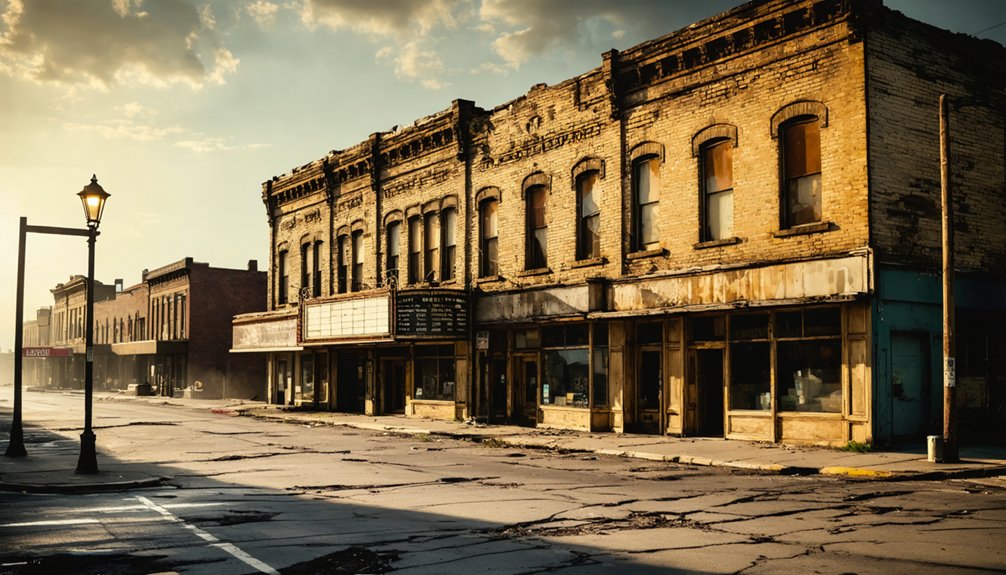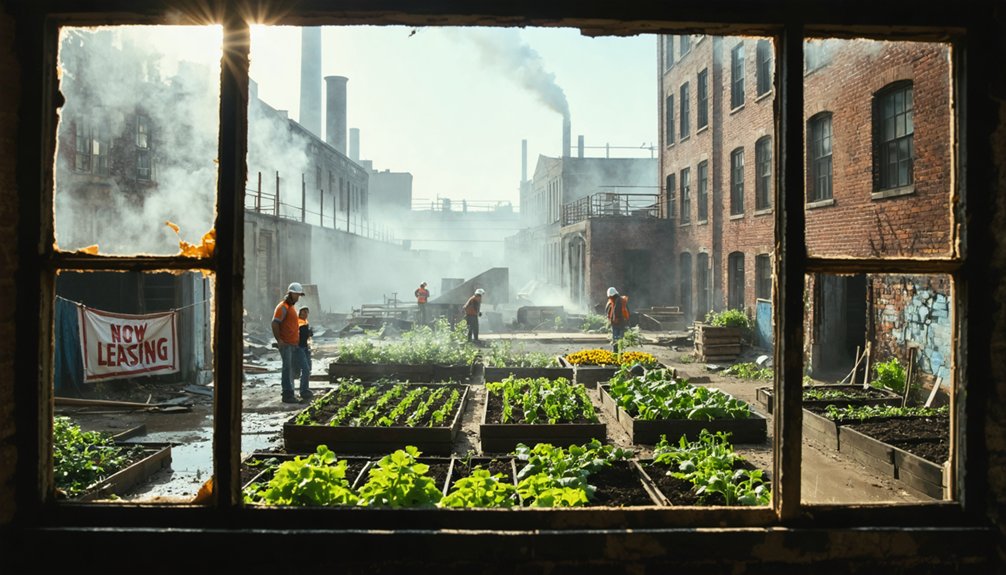You’ll find haunting beauty in abandoned Rust Belt towns, where skeletal factories and empty streets tell stories of economic collapse. Once-thriving manufacturing hubs now stand as eerie monuments to a vanished era, with nature steadily reclaiming crumbling infrastructure. Populations have plummeted by up to 65%, leaving communities fractured but resilient. Behind each rusting facade lies the complex human experience of loss, adaptation, and unexpected rebirth.
Key Takeaways
- Imposing industrial architecture like blast furnaces and smokestacks create dramatic silhouettes against post-industrial landscapes.
- Abandoned factories have transformed into wildlife habitats as nature reclaims spaces with vegetation breaking through concrete.
- Former manufacturing hubs like Youngstown and Detroit lost up to 65% of their populations after industrial decline.
- Photographers document decaying structures as powerful symbols of America’s manufacturing heritage and working-class history.
- Community preservationist coalitions work to save industrial landmarks while repurposing them as art spaces and community centers.
The Industrial Giants That Time Forgot
As you stand before the skeletal remains of America’s industrial past, it’s hard to imagine these rusted monoliths once pulsed with the lifeblood of entire communities. The massive steel mills of Gary and auto plants of Detroit weren’t just workplaces—they were economic ecosystems supporting thousands of families.
You’ll find these forgotten giants defined by their imposing industrial architecture: towering blast furnaces, sprawling factory floors, and smokestacks that pierce the sky. Their utilitarian brick and steel designs now stand as silent witnesses to America’s manufacturing decline.
What you’re seeing isn’t just decay—it’s the physical evidence of economic transformation. While some communities dream of economic revival, many of these single-industry towns struggle to reinvent themselves. These abandoned structures often harbor potential for redevelopment into art spaces or community hubs that could breathe new life into the area.
Their abandoned structures remain as monuments to ambition, engineering, and the workers who once made them hum. These post-industrial landscapes have become powerful subjects for photographers who document the intersection of history and collective memory in these rapidly changing urban identities.
Echoes of a Working-Class Past: Population Exodus
When steel mills shuttered and assembly lines ground to a halt, they didn’t just take jobs—they emptied entire communities.
The collapse of industry left behind not just economic wreckage, but hollow shells where communities once flourished.
You can see it in the stark demographic trends: cities like Youngstown hemorrhaging 65% of their population since 1930, with nearly a third vanishing in just the last two decades.
These aren’t just statistics—they’re the footprints of families who packed up and left. Detroit’s dramatic fall from 1.85 million residents in 1950 to fewer than 650,000 today illustrates the devastating impact of industrial decline. Education played a critical role in determining which cities recovered, with only 17% of US hubs able to return to prior employment levels. Economic factors drove this exodus as manufacturing collapsed, leaving behind aging populations and poverty rates exceeding 35% in some areas.
You’ll find the decline isn’t uniform; urban cores stand abandoned while some suburbs cling to stability.
What remains is a spatial reshuffling—high-income neighborhoods shrinking as poverty zones expand inward, creating reverse gentrification where working-class dreams once thrived.
Nature Reclaims What Humans Left Behind
While factory whistles no longer pierce the air, nature’s quiet advance has become the dominant sound in these forgotten Rust Belt towns.
You’ll witness vegetation encroachment transforming once-bustling streets into green corridors where vines strangle abandoned factories and moss carpets crumbling foundations.
Through broken windows and collapsed roofs, seeds find purchase, sprouting life where assembly lines once hummed.
Concrete cracks as persistent roots reclaim their territory inch by inch.
Former industrial waterways now host frogs and dragonflies in murky wetlands.
This wildlife resurgence signals nature’s resilience—birds nest in rusting machinery while deer wander freely through former neighborhoods.
Small mammals scurry across factory floors where workers once stood.
The slow transformation represents both decay and renewal, as contaminated soils gradually heal beneath nature’s patient hand.
Much like the SS Ayrfield in Australia, these abandoned structures have become vessels for mangrove tree ecosystems to flourish within the oxidizing remnants of human industry.
Similar to Concrete City’s abandoned duplexes, many structures remain structurally sound despite decades of exposure to harsh elements.
The Human Cost of Economic Transformation
Behind the rusting machinery and crumbling facades lies the true devastation of the Rust Belt’s decline: human suffering on a massive scale.
You’re witnessing the aftermath of economic transformation that stripped over 58% of manufacturing jobs, leaving communities fractured and spirits broken.
When factories closed, they didn’t just take jobs—they stole identities.
You’ll find economic hardship etched into the faces of those who stayed, their incomes growing 56% slower than those who fled. Non-college workers suffered most, with just 31% income growth over six decades.
Census data reveals that those born in the Rust Belt who migrated elsewhere experienced substantially higher income growth compared to those who remained.
Yet community resilience persists.
Amid economic devastation, neighbors stand shoulder to shoulder, refusing to surrender their collective hope.
Amid deteriorating infrastructure and limited opportunities, residents face higher rates of depression, substance abuse, and chronic health conditions.
The stigma of “ghost town” labels compounds their psychological burden, creating a stark portrait of America’s unfulfilled industrial promise.
Preserving Rust Belt Heritage Amid Decay
Despite decades of economic decline, the crumbling monuments of America’s industrial might still stand as symbols to a bygone era—waiting silently for someone to care.
You’ll find their architectural heritage slowly succumbing to harsh winters, acidic rain, and the weight of abandonment.
But there’s hope in the shadows. Young preservationist coalitions are forming across these forgotten landscapes, driven by the belief that community engagement can resurrect what’s been lost. The Rust Belt Coalition connects preservation groups across the region, hosting educational tours that showcase innovative revitalization projects.
They’re implementing sustainable practices to breathe new life into these spaces without erasing their industrial character.
The challenge isn’t just structural—it’s human. With populations dwindling, finding voices to champion preservation becomes increasingly difficult. Cities that once bustled with industry have experienced massive population losses, with Detroit’s numbers falling from 1.5 million to just 640,000 residents.
Yet in these ghost towns, where freedom from the past seems impossible, the most powerful restoration tool remains the community’s willingness to remember and rebuild.
Frequently Asked Questions
Are Any Rust Belt Towns Experiencing Successful Revitalization?
Yes. You’ll witness Detroit, Pittsburgh, and Cleveland rising from industrial ruins through successful initiatives in technology and arts, driven by passionate community engagement that’s transforming these once-desolate landscapes into beacons of renewal.
How Safe Is It to Explore Abandoned Rust Belt Buildings?
It’s extremely dangerous. You’re risking structural collapse, toxic exposure, arrest for trespassing, and violent encounters. Urban exploration demands serious safety precautions—respirators, partners, and permission—that most don’t take.
What Government Programs Exist to Help These Struggling Communities?
Like rusted gears seeking new purpose, you’ll find federal assistance through CDBG, TIGER grants, and brownfield remediation programs. Local initiatives include TIF districts and special economic zones for community rebirth.
Could These Towns Ever Return to Their Former Prosperity?
You’ll never witness their former industrial glory, but through economic revitalization strategies and community engagement initiatives, some towns could forge new identities—though most will remain shadows of their past.
How Do Current Residents Feel About “Ruin Tourism”?
You’ll find local perspectives deeply divided. Some welcome your tourism dollars, while others resent your voyeuristic gaze on their pain. The tourism impact cuts both ways—economic hope versus unwelcome intrusion.
References
- https://open.substack.com/pub/petesaunders/p/the-great-bones-of-rust-belt-cities?r=3patk&showWelcomeOnShare=true
- https://environment.sfsu.edu/sites/default/files/2023-02/AS362011GEOGS74.pdf
- https://www.youtube.com/watch?v=g00kMsxdpJ8
- https://www.britannica.com/place/Rust-Belt
- https://schoolofcities.utoronto.ca/neighbourhood-abandonment-in-the-american-rust-belt/
- https://backend.production.deepblue-documents.lib.umich.edu/server/api/core/bitstreams/e73fb3cd-4f75-4e88-b3b4-dcb2ecec2713/content
- https://www.clevelandfed.org/publications/economic-commentary/2013/ec-201306-urban-decline-in-rust-belt-cities
- https://en.wikipedia.org/wiki/Rust_Belt
- https://www.cato.org/blog/economic-mobility-not-manufacturing-decline-real-rust-belt-story
- https://plantandmachinery.caboodleai.net/article/166865/20-forgotten-industrial-sites-in-the-u.s.-that-are-eerily-beautiful



